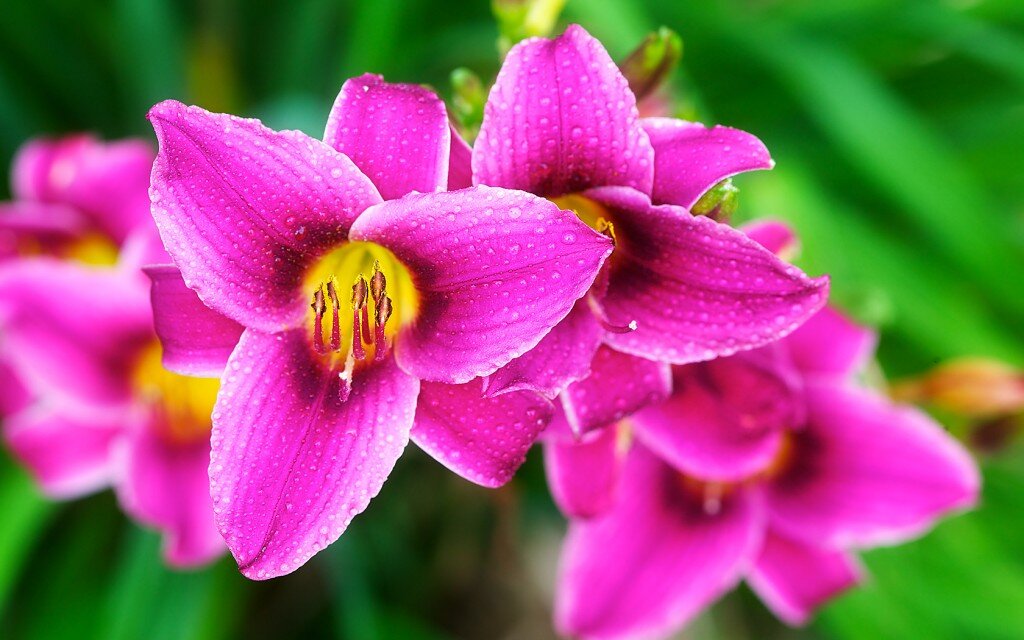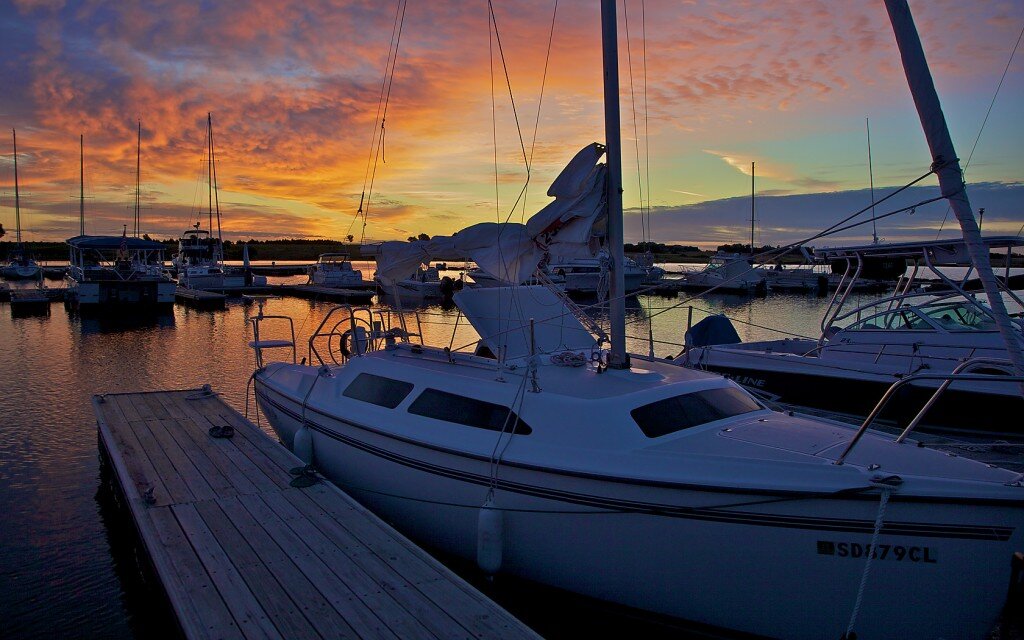Purple Dawn
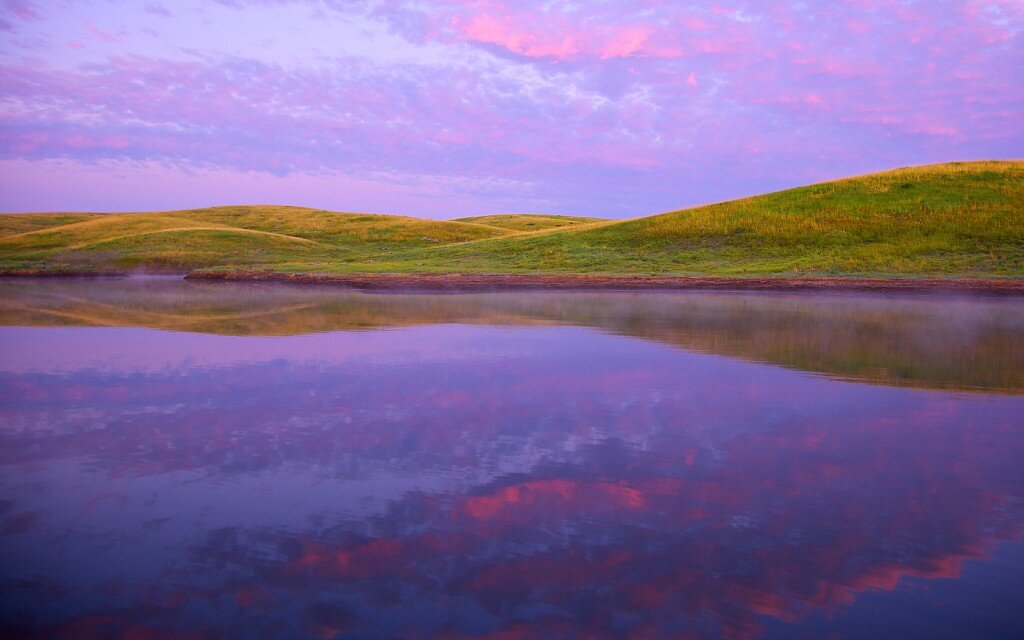 This is pretty much the same view as yesterday's post, though taken several minutes later with no sailboat to block the view.Seasoned Oahe boaters all know that one of the most unusual features of the shoreline this summer is that for late August, things are still incredibly green. Pierre, SD, which lies just south of the reservoir, has had 8" more rain than it normally gets by this time in August.For the sake of comparison, check out this shot of the Little Bend camp ground taken in early September in 2005 when the reservoir water level was much lower and central South Dakota was experiencing a more typical dry summer. As I study the 2005 photo, today's post makes it look almost tropical on the western shore of Lake Oahe.For those who like analogies, check out another sunrise photo taken of the Missouri in mid-winter. The hues are similar, though the water temperature is a few degrees cooler. :-)
This is pretty much the same view as yesterday's post, though taken several minutes later with no sailboat to block the view.Seasoned Oahe boaters all know that one of the most unusual features of the shoreline this summer is that for late August, things are still incredibly green. Pierre, SD, which lies just south of the reservoir, has had 8" more rain than it normally gets by this time in August.For the sake of comparison, check out this shot of the Little Bend camp ground taken in early September in 2005 when the reservoir water level was much lower and central South Dakota was experiencing a more typical dry summer. As I study the 2005 photo, today's post makes it look almost tropical on the western shore of Lake Oahe.For those who like analogies, check out another sunrise photo taken of the Missouri in mid-winter. The hues are similar, though the water temperature is a few degrees cooler. :-)
First Light In Mission Creek
 I made the 15 mile trip from the Spring Creek Marina to Mission Creek largely under power since the wind was light to non-existant. The weather forecast was for good weather overnight and light winds in the morning. For me there isn't much better in my sailing world than to wake up in a remote bay with calm winds and the hint of a glorious sunrise. And this morning was one of those experiences.When I first slid the hatch cover open and put my head out, I wasn't thinking of taking photos. But right away I noticed very light fog low on the water, which I thought was interesting. I also liked the curves of the sloping green hills that came down to the water's edge.Compositionally and aesthetically, then, I liked what I saw. But the problem was that there was very little light. But knowing that the camera sees things in ways that the eye can't, I thought that I'd crank up the ISO and see what I got. And you are looking at it.
I made the 15 mile trip from the Spring Creek Marina to Mission Creek largely under power since the wind was light to non-existant. The weather forecast was for good weather overnight and light winds in the morning. For me there isn't much better in my sailing world than to wake up in a remote bay with calm winds and the hint of a glorious sunrise. And this morning was one of those experiences.When I first slid the hatch cover open and put my head out, I wasn't thinking of taking photos. But right away I noticed very light fog low on the water, which I thought was interesting. I also liked the curves of the sloping green hills that came down to the water's edge.Compositionally and aesthetically, then, I liked what I saw. But the problem was that there was very little light. But knowing that the camera sees things in ways that the eye can't, I thought that I'd crank up the ISO and see what I got. And you are looking at it.
Another View
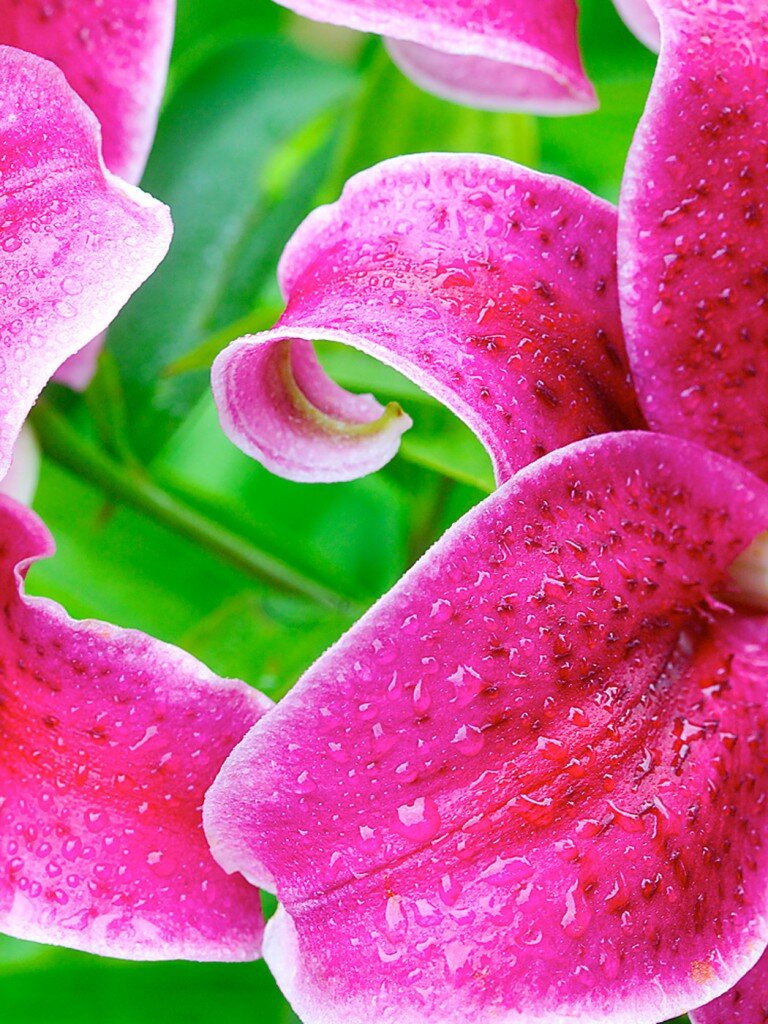 I think this is the third year I have photographed this lilly and this morning when I took my tripod and camera out to the garden, my goal was to try to see this beautiful plant in a way I hadn't seen it before.I have said before that photographers have the power to define reality by framing the field of view in ways that the human eye and brain don't. Thus, we can show the "big picture" in a way that makes it interesting and we can move in close to show things that people wouldn't normally look at. This photo is an example of this, I think.When I took this photo, I stopped looking at the whole flower and instead looked at its parts, its lines and it colors. I also looked at how these parts related to the background. To me an important compositional element is the way the edges of the leaves define the green space in the middle.Is it a good photo? I'm not sure that I could ever answer that question about one of my pictures. All I know is that I feel I met my goal of giving people a new way to look at the stargazer lilly.
I think this is the third year I have photographed this lilly and this morning when I took my tripod and camera out to the garden, my goal was to try to see this beautiful plant in a way I hadn't seen it before.I have said before that photographers have the power to define reality by framing the field of view in ways that the human eye and brain don't. Thus, we can show the "big picture" in a way that makes it interesting and we can move in close to show things that people wouldn't normally look at. This photo is an example of this, I think.When I took this photo, I stopped looking at the whole flower and instead looked at its parts, its lines and it colors. I also looked at how these parts related to the background. To me an important compositional element is the way the edges of the leaves define the green space in the middle.Is it a good photo? I'm not sure that I could ever answer that question about one of my pictures. All I know is that I feel I met my goal of giving people a new way to look at the stargazer lilly.
One Good Tern. . .
 . . . deserves another, as the saying goes.The birds in this photo are least terns, whose nesting habitat, according to the Cornell Lab of Ornithology, "is found . . . on sandy beaches along the southern coasts of the United States and up the major river systems far into the interior of the continent."Certainly, Lake Oahe counts as "far into the interior", though they also nest along the Missouri River as far north and west as Montana. On Lake Oahe, they can be found standing along remote shorelines, floating peacefully on the water or resting on the rubber tire breakwaters at Spring Creek. Occasionally, their rest is interrupted by sailor/photographers who like to motor close to the tires just to watch the birds take flight.Lewis and Clark observed these birds and wrote about them in their journals. They even took two specimens for their collection. The birds were dead, of course, though I guess you could say the same about Lewis and Clark these days. . . .Living least terns go south in the winter, along with other South Dakota snowbirds. Where do they go? Mexico and South Padre Island are possibilities. But not Phoenix or Sun City.
. . . deserves another, as the saying goes.The birds in this photo are least terns, whose nesting habitat, according to the Cornell Lab of Ornithology, "is found . . . on sandy beaches along the southern coasts of the United States and up the major river systems far into the interior of the continent."Certainly, Lake Oahe counts as "far into the interior", though they also nest along the Missouri River as far north and west as Montana. On Lake Oahe, they can be found standing along remote shorelines, floating peacefully on the water or resting on the rubber tire breakwaters at Spring Creek. Occasionally, their rest is interrupted by sailor/photographers who like to motor close to the tires just to watch the birds take flight.Lewis and Clark observed these birds and wrote about them in their journals. They even took two specimens for their collection. The birds were dead, of course, though I guess you could say the same about Lewis and Clark these days. . . .Living least terns go south in the winter, along with other South Dakota snowbirds. Where do they go? Mexico and South Padre Island are possibilities. But not Phoenix or Sun City.
Sheepish
Morning At the Marina
Relic - Window Detail
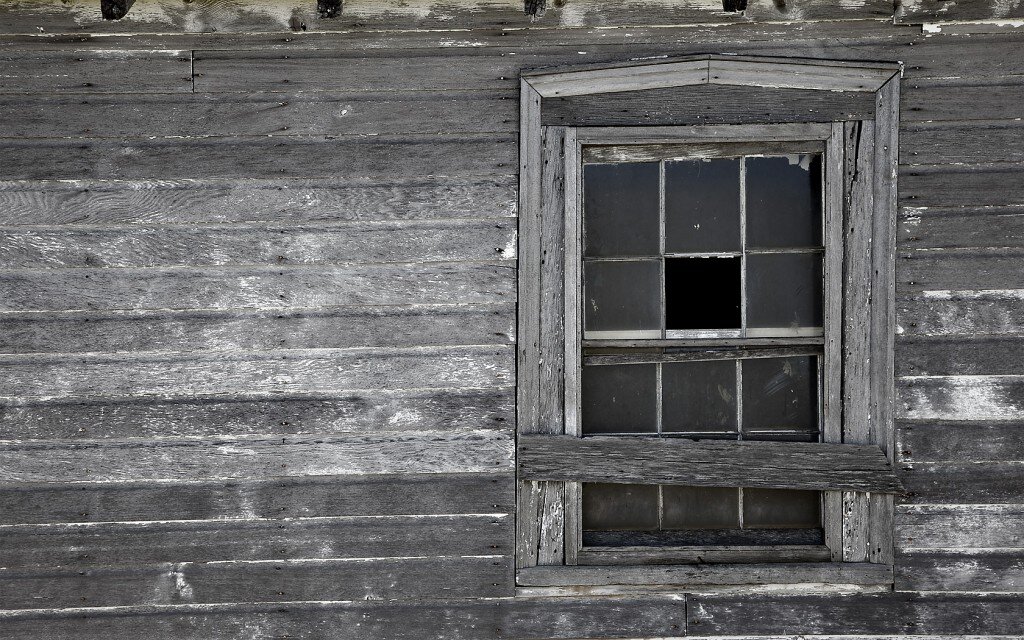 This window was one of several that graced the house I posted yesterday. What is interesting to me is that a supremely isolated residence built on the bluffs of the Missouri River would like have been a utilitarian structure - a roof, walls, doors and windows.But these windows aren't standard windows, as far as I can tell. You can see the detail above the window is an added touch that graces the architecture of this place. I admire the spirit of a builder who adds a flourish that isn't likely to be appreciated by neighbors. This unknown builder was merely trying to please himself.
This window was one of several that graced the house I posted yesterday. What is interesting to me is that a supremely isolated residence built on the bluffs of the Missouri River would like have been a utilitarian structure - a roof, walls, doors and windows.But these windows aren't standard windows, as far as I can tell. You can see the detail above the window is an added touch that graces the architecture of this place. I admire the spirit of a builder who adds a flourish that isn't likely to be appreciated by neighbors. This unknown builder was merely trying to please himself.
Relic
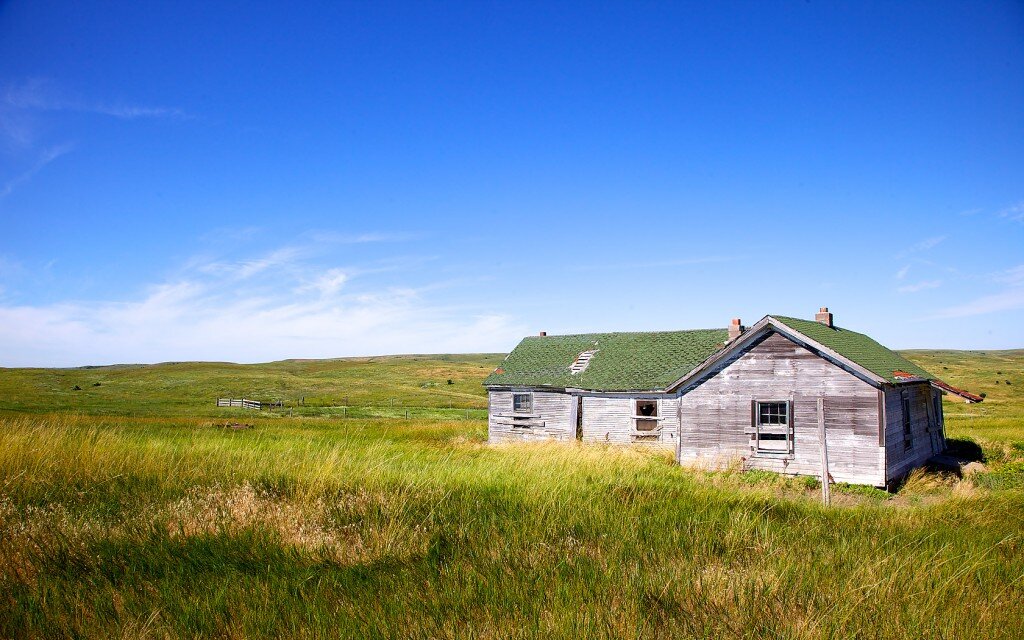 One bay west of what local sailors call "Hurricane Bay" a structure of some kind is just barely visible above the bluffs, which rise at least 70 feet above Lake Oahe. I have dubbed this bay "House Cove," though I'm sure there is some other name for it.Yesterday, I pulled Wandering Star up to shore and hiked up the bluffs to see what the "house" might be. And, in fact, it was a house - but one that had been vacated years or even decades before. There was evidence of electricity, though it was also clear that this structure had started as a one room timber frame building and then been augmented with two or three more rooms. Could this house have been some kind of outpost for Fort Sully, which used to stand on the opposite shore and which was vacated in 1893?I didn't venture in to the house because I was worried that the floors might not bear my weight. As I stood near what used to be the front porch and looked northeast, I could only imagine what the original inhabitants would have seen long before the Oahe Dam was built. And I could only imagine what kind of rugged, independent, self-reliant people might might have lived in this isolated home.(To get sense of the geography, checked out the photo on Panoramio.)
One bay west of what local sailors call "Hurricane Bay" a structure of some kind is just barely visible above the bluffs, which rise at least 70 feet above Lake Oahe. I have dubbed this bay "House Cove," though I'm sure there is some other name for it.Yesterday, I pulled Wandering Star up to shore and hiked up the bluffs to see what the "house" might be. And, in fact, it was a house - but one that had been vacated years or even decades before. There was evidence of electricity, though it was also clear that this structure had started as a one room timber frame building and then been augmented with two or three more rooms. Could this house have been some kind of outpost for Fort Sully, which used to stand on the opposite shore and which was vacated in 1893?I didn't venture in to the house because I was worried that the floors might not bear my weight. As I stood near what used to be the front porch and looked northeast, I could only imagine what the original inhabitants would have seen long before the Oahe Dam was built. And I could only imagine what kind of rugged, independent, self-reliant people might might have lived in this isolated home.(To get sense of the geography, checked out the photo on Panoramio.)
A View From Above
Another Sunrise
 The sun comes up every day, of course. In my life, there have been close to 21,000 sunrises and sunsets. On a small fraction of those 21,000 days I have been out with my camera. And on those rare days that I have my camera, it is rarer still to have the luck of good timing and photogenic skies.But this was one one of those mornings.
The sun comes up every day, of course. In my life, there have been close to 21,000 sunrises and sunsets. On a small fraction of those 21,000 days I have been out with my camera. And on those rare days that I have my camera, it is rarer still to have the luck of good timing and photogenic skies.But this was one one of those mornings.
Not From Around Here
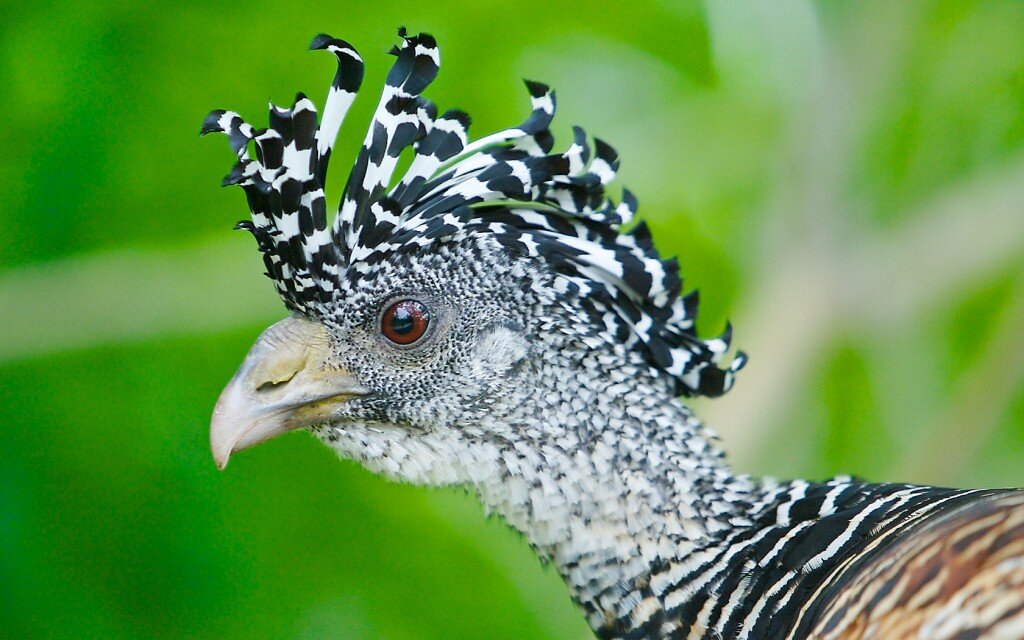 Here's a thought: this bird is related to the common sparrows that are plentiful in South Dakota. The evolutionary difference between this colorful bird and a sparrow is the environment their ancestors developed in. In the case of the sparrow, there is plenty of brown.In the case of this Mexican bird, though, the tropics have much more color, such as Hawaiian shirts and colorful bikinis. It's all about blending in . . .
Here's a thought: this bird is related to the common sparrows that are plentiful in South Dakota. The evolutionary difference between this colorful bird and a sparrow is the environment their ancestors developed in. In the case of the sparrow, there is plenty of brown.In the case of this Mexican bird, though, the tropics have much more color, such as Hawaiian shirts and colorful bikinis. It's all about blending in . . .

